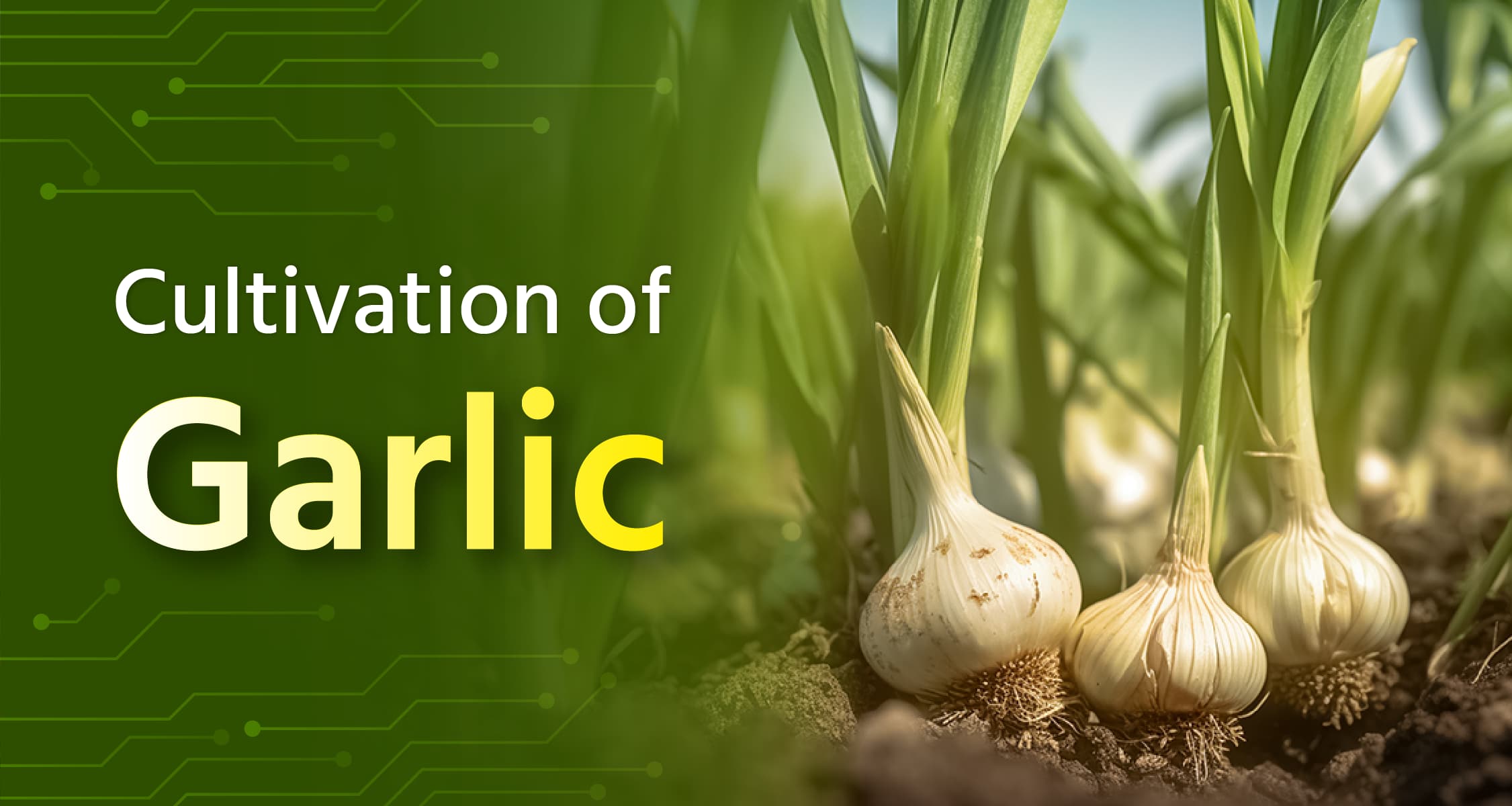Cultivation of Garlic

Garlic is a crop widely used as a spice to enhance the flavor of vegetables and various dishes. Due to its many medicinal properties, there is always a demand for garlic. It is primarily cultivated in Gujarat, Madhya Pradesh, Uttar Pradesh, Rajasthan, and Tamil Nadu. In addition, garlic can be grown throughout India.
If you are interested in garlic cultivation, read this post carefully for detailed information on the ideal cultivation time, suitable soil and climate, preparation for farming, sowing methods, irrigation and weed management, pest and disease control, and harvesting techniques.
How to Cultivate Garlic?
Optimal Time for Garlic Cultivation
- The best time to sow garlic is between October and November. During this period, the temperature is mildly cool, which is ideal for the proper development of garlic crops. In some regions, sowing can also begin at the end of September or the start of October.
Suitable Climate
- Garlic grows well in cool and temperate climates. The ideal temperature for its cultivation ranges between 12-24°C. For germination, a temperature of 10-15°C is best, while 15-20°C is optimal for bulb development. Excessive cold or frost can be harmful to the crop. Garlic requires adequate sunlight, so it should be cultivated in areas that receive 6-8 hours of sunlight daily.
Suitable Soil
- Garlic grows best in loamy or sandy loam soils with good drainage. The soil pH should be between 6-8. If the soil is too acidic or alkaline, it can reduce the yield. The field soil should also be rich in organic matter to provide the plants with all the essential nutrients they need.
Best Varieties
- For good yields, choose varieties such as Yamuna Safed 1 (G-1), Yamuna Safed 2 (G-50), Yamuna Safed 3 (G-282), Yamuna Safed 4 (G-323), Bhima Purple, VL Garlic 1, PG 17, etc.
Seed Quantity
- For cultivation on one acre of land, 1.5 to 2 quintals of cloves are required. To protect the crop from various diseases, treat the cloves with fungicides before transplanting.
Field Preparation Method
- The soil must be crumbly for garlic cultivation. While preparing the field, remove the remnants of previous crops. Perform a deep plowing of the field once. After this, plow 2-3 times lightly and make the soil crumbly and level. During the final plowing, apply 6 tons of cow dung manure or compost per acre. Additionally, apply 52 kg of urea, 34 kg of Di-Ammonium Phosphate (DAP), 26 kg of Muriate of Potash (MOP), and 16 kg of sulfur per acre. After 30 days, 45 days, and 60 days of transplanting the cloves, apply 5 grams of DeHaat NutriOne NPK 19:19:19 per liter of water.
Planting Method
- Garlic is cultivated by planting cloves. Plant the cloves in rows, keeping a distance of 6 inches between rows. There should be a gap of 4 inches between each plant. The cloves should be planted at a depth of about 1 inch.
Irrigation Management
- For better yield, give light irrigation immediately after planting the cloves. After that, irrigate the field at intervals of 8 to 12 days, depending on the need. During the bulb development stage, garlic requires more moisture, so you can increase the frequency of irrigation at this time. Stop irrigating when the leaves start drying at the time of harvesting, allowing the bulbs to dry properly.
Weed Control
- Weeds in the field can hinder the proper growth of garlic cloves and bulbs, making weed control essential. Perform the first weeding about 30-40 days after planting. After 15-20 days from the first weeding, perform another weeding. To control weeds, you can use organic mulching by laying straw between the rows. If the weed problem worsens, consult agricultural experts and use chemical herbicides as recommended.
Disease and Pest Control
- Garlic crops are prone to various diseases and pests such as powdery mildew, root rot, damping-off, blight, leaf spot, thrips, aphids, and nematodes. To protect the crop from these diseases and pests, use appropriate fungicides and insecticides. Pay special attention to the dosage of chemical treatments to prevent any damage to the plants.
Harvesting the Crop
- Garlic is ready for harvest approximately 120-150 days after sowing. Harvest the crop when the plant leaves turn yellow and begin to droop. To retain moisture in the bulbs, harvest the crop during the morning or evening hours. After harvesting, trim the dry leaves from the bulbs and allow them to dry for 3-5 days. Once dried, separate the garlic bulbs from the leaves and store them properly.
Which fertilizers are used in garlic farming? Tell us your answer in the comments. For more information like this, make sure to follow the 'Krishi Gyan' channel now. If you found this information useful, don't forget to like and share this post.
Frequently Asked Questions (FAQs)
Q: What should be done to increase the size of garlic bulbs?
A: To increase the size of garlic cloves or bulbs, irrigate regularly and apply fertilizers in the right amount at the right time. Keep the crop protected from weeds, diseases, and pests.
Q: How many days does it take for garlic to germinate?
A: Garlic takes about 7-10 days to sprout.
Q: When should garlic be harvested?
A: Garlic should be harvested when the leaves start to turn yellow and dry. Do not leave the crop in the soil for too long after the leaves turn yellow and dry. Harvest in time to prevent the garlic bulbs from splitting.
जारी रखने के लिए कृपया लॉगिन करें

फसल चिकित्सक से मुफ़्त सलाह पाएँ
